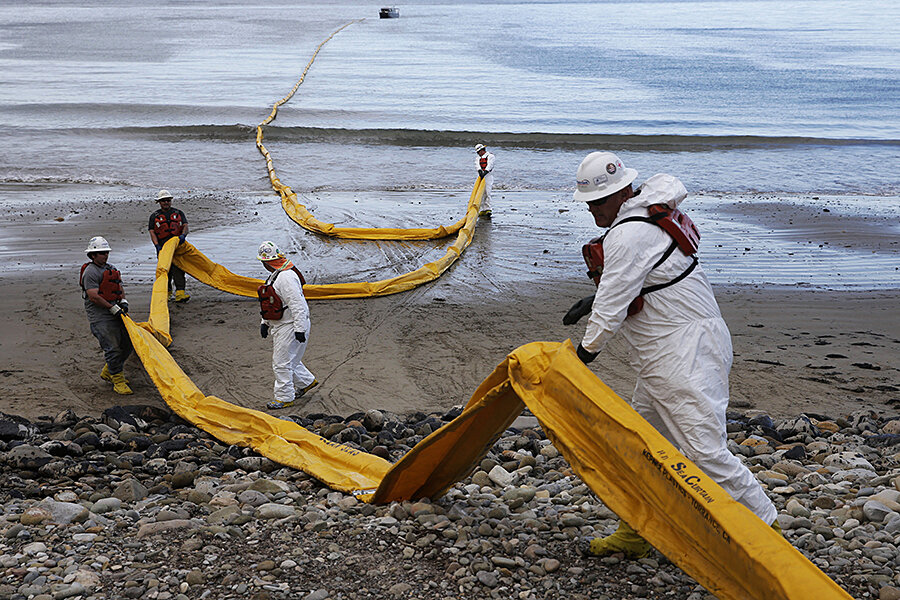Exxon Mobil halts 3 oil platforms in wake of pipeline spill
Loading...
| Los Angeles
Exxon Mobil Corp. has been forced to halt operations at three offshore oil platforms because it couldn't deliver to refineries in the wake of a broken pipeline that spilled up to 101,000 gallons of crude on the Santa Barbara coast, the company said.
Operations temporarily ceased last week because Santa Barbara County rejected its emergency application to truck oil to refineries, spokesman Richard Keil said Tuesday.
A Santa Barbara County official said the company's problem did not constitute an emergency and it could go through the normal procedure, which requires extensive environmental review, to get a permit to truck the oil.
The shutdown is not expected to have an effect on oil prices, but it does harm Exxon Mobil's bottom line even though production from the platforms is small compared with the company's overall output, said Tom Kloza, global head of energy at the Oil Price Information Service.
Crude was selling last week for $60 to $64 a barrel and could fetch more than $91 when refined for automobile gas, he said. That provided a lot of incentive for Exxon Mobil.
"I'm sure it's a royal pain for them," Kloza said. "Given the profit margins for gasoline, whether you have to (deliver) it by wheelbarrow or rickshaw, you're very motivated."
Exxon Mobil had cut production from the rigs by two-thirds after Plains All American Pipeline's conduit was shut down by a May 19 spill that soiled pristine coastline and spread tar balls as far as Los Angeles County, about 100 miles away. Nearly 200 birds and more than 100 marine mammals have been found dead in the waters.
Federal regulators investigating the cause of the spill have revealed the 2-foot-wide pipe was severely corroded where it ruptured but have not issued any findings or penalties.
The pipeline carried oil to refineries from an Exxon Mobil facility in Las Flores Canyon that separates crude, water and natural gas about 15 miles west of Santa Barbara.
Before the shutdown, daily production from the Hondo, Harmony and Heritage rigs that sit 5 to 8 miles offshore had been cut from 30,000 barrels to 10,000 barrels.
That production is just a sliver of the more than 4 million barrels per day Exxon Mobil reported in the first quarter of the year. There are 42 gallons in a barrel.
While the plant is capable of storing up to 540,000 barrels of crude, the company said it expected to reach capacity less than a month after it filed its June 4 emergency application.
Plains has not provided an estimate of when it might be able to restart the pipeline after meeting federal regulators' requirements.
Meanwhile, Exxon Mobil is weighing options, Keil said.
No immediate layoffs are anticipated because the platforms need to be maintained while dormant, Keil said.
The company's bigger problem in California, Kloza said, is getting its Torrance refinery restarted after a fire earlier this year.
The biggest local effect of a prolonged shutdown will be on Santa Barbara County's tax revenue, said Mark Schniepp, director of the California Economic Forecast.
Exxon Mobil said in its emergency application that the county stands to lose up to $4 million in school funding if the Las Flores Canyon facility shuts down.
"When the county says, 'No, we're not going to give you that permit,' they're just shooting themselves in the foot," Schniepp said.
In rejecting the permit June 9, Dianne Black, assistant planning director for the county, said schools could file a claim against Plains if they lose funding through tax revenue.
Exxon Mobil had planned to have eight trucks per hour haul oil around the clock to a Phillips 66 refinery 70 miles away.
Phillips has operated its Santa Maria refinery at a reduced rate since the spill but is still meeting the demands of customers in the area, spokesman Dennis Nuss said.







